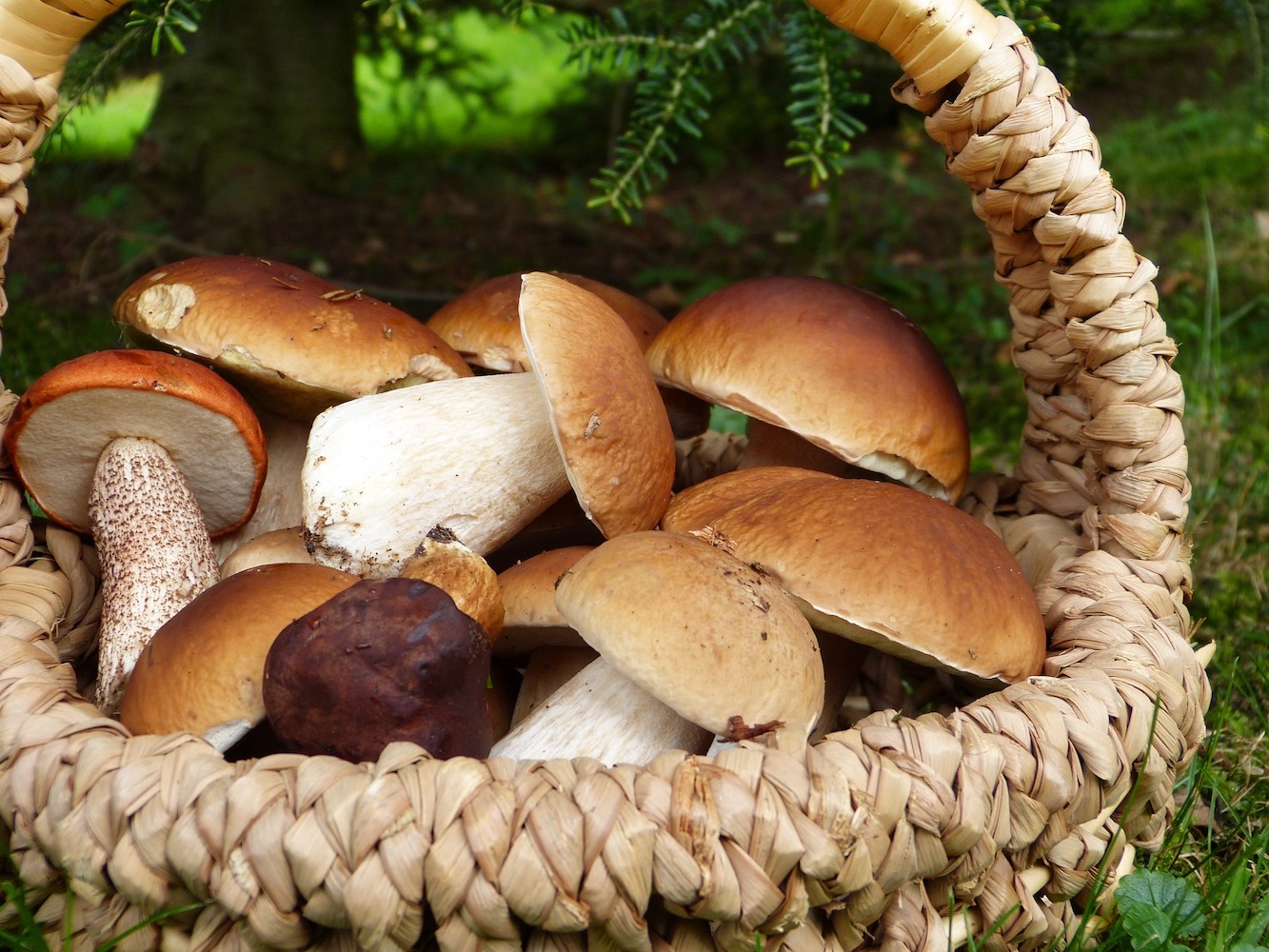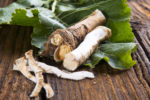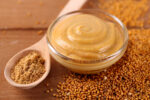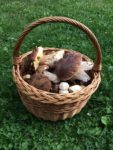
Making Mushroom Ketchup (Catsup)
Many recipes from old cookbooks called for mushroom ketchup – especially meat recipes. I had never heard of mushroom ketchup before and haven’t found it in any health food or specialty food stores. I did discover that the Geo Watkins Company makes Mushroom Ketchup and you can order it online.
INFORMATION BELOW FROM 1800s COOKBOOKS
TO MAKE MUSHROOM KETCHUP
Look out for mushrooms from the beginning of September. Choose full-grown mushroom-flaps and take care they are perfectly fresh-gathered when the weather is tolerably dry. For if they are picked during very heavy rain, the ketchup from which they are made is liable to get musty, and will not keep long.
Put a layer of these at the bottom of a deep earthen pan and sprinkle them with salt. Then add another layer of mushrooms, put some more salt on them, and so on, alternately, salt and mushrooms. Let them remain two or three hours, by which time the salt will have penetrated the mushrooms and rendered them easy to break.
Then pound them in a mortar or mash them well with your hands, and let them remain for a couple of days, not longer, stirring them up, and mashing them well each day. Then pour them into a stone jar and to each quart add an ounce and a half of whole black pepper, and half an ounce of allspice. Stop the jar very close, and set in a stew-pan of boiling water and keep it boiling for two hours at least.
Take out the jar and pour the juice clear from the settlings, through a hair sieve* (without squeezing the mushrooms) into a clean stew-pan and let it boil very gently for half an hour. Those who are for superlative ketchup will continue the boiling till the mushroom juice is reduced to half the quantity. There are several advantages attending this concentration: it will keep much better and only half the quantity will be required, so you can flavor sauce and soup without thinning it.
Skim it well and pour it into a clean dry jar or jug. Cover it close, and let it stand in a cool place till the next day, then pour it off as gently as possible (so as not to disturb the settlings at the bottom of the jug), through a thick flannel bag, till it is perfectly clear. Add a tablespoon of good brandy to each pint of ketchup and let it stand as before. A fresh sediment will be deposited, from which the ketchup is to be quietly poured off and bottled in pints or half pints (which have been washed in brandy or spirits). The bottles should be quite small, as the ketchup soon spoils after being opened.
Take especial care that the bottles are closely corked and sealed down. If kept in a cool dry place, they may be preserved for a long time. But if they be badly corked and kept in a damp place, they will soon spoil. Examine them from time to time by placing a strong light behind the neck of a bottle and if any pellicle* appears about it, boil it up again with a few peppercorns.
*hair sieve – a strainer with a wiry fabric bottom usually woven from horsehair.
*pellicle – a thin skin, membrane, or film.
MUSHROOM KETCHUP NO. 2
Take the largest broad mushrooms, break them into an earthen pan, strew* salt over, and stir them occasionally for three days. Then let them stand twelve days till there is a thick scum over them. Strain and boil the liquor with Jamaica and black peppers, mace, ginger, a clove or two, and some mustard seed. When cold, bottle it, and tie a bladder* over the cork. In three months, boil it again with fresh spice, and it will then keep a twelvemonth.
*strew – to scatter or spread untidily over a surface or area.
*bladder – the bladder from an animal was used to cover mincemeat, potted meat, etc., to exclude the air.
Another Way — Fill a stew-pan with large flap mushrooms. Throw a handful of salt among them and set them by a slow fire. They will produce a great deal of liquor, which must be strained. Then add four ounces of shallots, two cloves of garlic, a good deal of whole pepper, ginger, mace, cloves, and a few bay leaves. Boil and skim it well and when cold, cork it up close. In two months boil it up again with a little fresh spice and a stick of horseradish. It will then keep a year, which mushroom ketchup rarely does, if not boiled a second time.
MUSHROOM KETCHUP No. 3
To a peck of mushrooms, allow one-half pound of salt. Put a layer of them in a deep pan, sprinkle salt over them, and then another layer of mushrooms, and so on alternately. Let them remain for a few hours, then break them up with the hand. Put them in a nice cool place for three days, occasionally stirring and mashing them well, to extract from them as much juice as possible.
Now measure the quantity of liquor without straining and to each quart, add one-fourth ounce of cayenne, one-half ounce of allspice, one-half ounce of ginger, and two blades of pounded mace. Put all into a stone jar, cover it up very closely, and put it in a saucepan of boiling water. Set it over the fire, and let it boil for three hours. Have ready a nice clean stew-pan, turn into it the contents of the jar, and let the whole simmer very gently for one-half hour. Pour it into a jug, where it should stand in a cool place till the next day. Then pour it off into another jug, and strain it into very dry clean bottles; do not squeeze the mushrooms. To each pint of ketchup add a few drops of brandy. Be careful not to shake the contents, but leave all the sediment behind in the jug. Cork well, and either seal or rosin the cork, so as perfectly to exclude the air.
When a very clear bright ketchup is wanted, the liquor must be strained through a very fine hair-sieve, or flannel bag, after it has been very gently poured off. If the operation is not successful, it must be repeated until you have quite a clear liquor. It should be examined occasionally, and if it is spoiling, should be reboiled with a few peppercorns.
Note.—This flavoring ingredient, if genuine and well prepared, is one of the most useful store sauces to the experienced cook, and no trouble should be spared in its preparation. Double ketchup is made by reducing the liquor to half the quantity. For example, one quart must be boiled down to one pint. This goes farther than ordinary ketchup, as so little is required to flavor a good quantity of gravy. The sediment may also be bottled for immediate use, and will be found to answer for flavoring thick soups or gravies.
Image by silviarita from Pixabay
=================================================
Have You Ever Heard of Mushroom Ketchup? Please Leave a Comment Below
=================================================
Geo Watkins Mushroom Ketchup – 190m
This rich cooking sauce was the secret of success for many Victorian Cooks. For pies, puddings, sauces, meats, and more.
Suitable for Vegetarians, Vegans. 8 – 12 Days Delivery.





6 thoughts on “Making Mushroom Ketchup (Catsup)”
I’ve been using the Watkins mushroom ketchup for at least 20 years. I mostly add it to Bolognese sauce (along with anchovy sauce, another Watkins product) but it’s good in almost any meat sauce or marinade. As it’s virtually unobtainable here in France, I’ll definitely be having a go at making it. I’ll probably use the bits I like best from these recipes and add some modern touches – like sterilising jars and using a food processor!
I’m sure you’ll find a combination of ingredients you like to make your own mushroom ketchup. I’m like you; I love reading about how foods were prepared long ago, but do like modern conveniences.
Quite a process! My mother made tomato ketchup a couple of times in a big stoneware crock. She found it too much trouble and we just had ketchup from the store after that.
I agree it’s a lot of work. I’d like to try mushroom ketchup, though, to see what it tastes like.
Never heard of mushroom catsup and I real old newspapers all the time. Or maybe I just blocked out the recipe because I hate mushrooms. Wish I didn’t since they are so good for you.
Hate is a strong word. My granddaughter “hates” a lot of foods because of the texture or mouthfeel, but she loves my lasagna that is riddled with minced mushrooms – although she “hates” mushrooms. For what it’s worth 😉